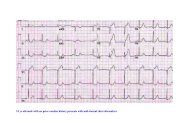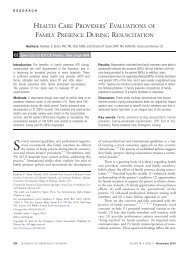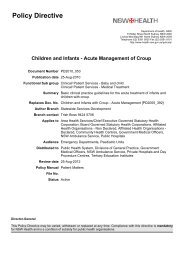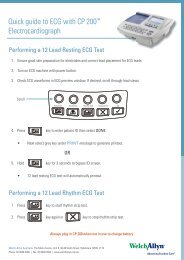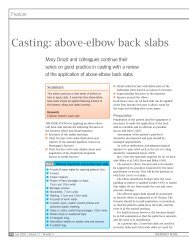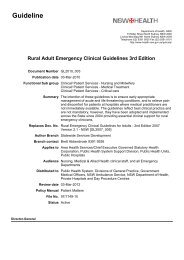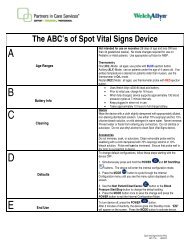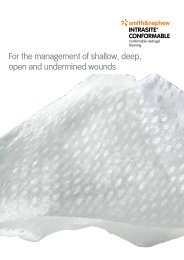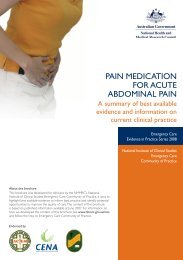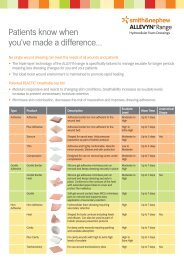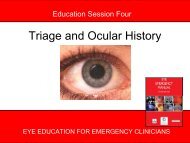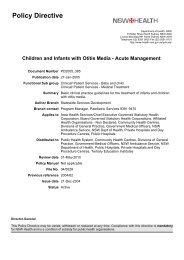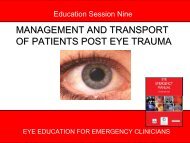Clinical Guidelines for Acute Stroke Management - Living on the EDge
Clinical Guidelines for Acute Stroke Management - Living on the EDge
Clinical Guidelines for Acute Stroke Management - Living on the EDge
You also want an ePaper? Increase the reach of your titles
YUMPU automatically turns print PDFs into web optimized ePapers that Google loves.
1 ORGANISATION OF SERVICES<br />
1 Organisati<strong>on</strong> of Services<br />
6Secti<strong>on</strong><br />
1.1 <str<strong>on</strong>g>Stroke</str<strong>on</strong>g> unit care<br />
The organisati<strong>on</strong> of hospital services to provide stroke<br />
unit care is <strong>the</strong> single most important recommendati<strong>on</strong><br />
<str<strong>on</strong>g>for</str<strong>on</strong>g> acute stroke management. <str<strong>on</strong>g>Stroke</str<strong>on</strong>g> unit care should<br />
be <strong>the</strong> highest priority <str<strong>on</strong>g>for</str<strong>on</strong>g> clinicians and administrators<br />
to c<strong>on</strong>sider. There is overwhelming evidence that<br />
stroke unit care significantly reduces death and<br />
disability after stroke compared with c<strong>on</strong>venti<strong>on</strong>al care<br />
in general wards <str<strong>on</strong>g>for</str<strong>on</strong>g> all people with stroke. 6<br />
Models of stroke care described in <strong>the</strong> literature<br />
include:<br />
> acute stroke ward: acute unit in a discrete ward;<br />
> comprehensive stroke unit care: combined acute<br />
and rehabilitati<strong>on</strong> unit in a discrete ward;<br />
> stroke rehabilitati<strong>on</strong> unit: a discrete rehabilitati<strong>on</strong> unit<br />
<str<strong>on</strong>g>for</str<strong>on</strong>g> people with stroke, who are transferred from<br />
acute care 1-2 weeks post stroke;<br />
> mixed rehabilitati<strong>on</strong> ward: rehabilitati<strong>on</strong> provided <strong>on</strong><br />
a ward managing a general caseload.<br />
In Australia, most stroke units established to date have<br />
a primary focus <strong>on</strong> early (acute) care and early aspects<br />
of rehabilitati<strong>on</strong>, with varying degrees of intensity and<br />
follow-up. However, <strong>the</strong> evidence <str<strong>on</strong>g>for</str<strong>on</strong>g> stroke unit care is<br />
clearest <str<strong>on</strong>g>for</str<strong>on</strong>g> units that can provide several weeks of<br />
rehabilitati<strong>on</strong> (<strong>on</strong> a comprehensive stroke unit or stroke<br />
rehabilitati<strong>on</strong> unit).<br />
6, 18, 19<br />
The stroke units that have been shown to deliver<br />
highly effective stroke care share a number of<br />
characteristics, including:<br />
> locati<strong>on</strong> in a geographically discrete unit;<br />
> comprehensive assessments;<br />
> a coordinated interdisciplinary team;<br />
> early mobilisati<strong>on</strong> and avoidance of bed rest;<br />
> staff who have a special interest in <strong>the</strong> management<br />
of stroke, and access to <strong>on</strong>going professi<strong>on</strong>al<br />
educati<strong>on</strong> and training;<br />
> clear communicati<strong>on</strong>, with regular team meetings<br />
to discuss management (including discharge<br />
planning) and o<strong>the</strong>r meetings as needed<br />
(e.g. family c<strong>on</strong>ferences);<br />
> active encouragement of people with stroke and<br />
<strong>the</strong>ir carers/family members to be involved in <strong>the</strong><br />
rehabilitati<strong>on</strong> process.<br />
6, 18<br />
A mobile stroke team has been suggested as <strong>on</strong>e<br />
strategy to improve processes of care <str<strong>on</strong>g>for</str<strong>on</strong>g> hospitals<br />
that do not currently have a dedicated stroke unit. 20<br />
One robust systematic review found no clear benefit<br />
<str<strong>on</strong>g>for</str<strong>on</strong>g> mobile stroke teams. The <strong>on</strong>ly significant benefit<br />
related to a process outcome (documented OT<br />
assessment) with n<strong>on</strong> significant trends reported <str<strong>on</strong>g>for</str<strong>on</strong>g><br />
improved patient outcomes. 21 Mobile stroke teams are<br />
generally not more effective than care <strong>on</strong> a general<br />
ward but are inferior to care <strong>on</strong> a stroke unit. 21 Hence<br />
based <strong>on</strong> best available data mobile stroke teams are<br />
not <strong>the</strong> answer to regi<strong>on</strong>al hospitals or metropolitan<br />
hospitals without a stroke unit. In such situati<strong>on</strong>s it is<br />
recommended that a small (2-4 bed) geographically<br />
based stroke unit be established as part of a larger<br />
general ward. In larger hospitals, a comprehensive<br />
stroke unit is c<strong>on</strong>sidered <strong>the</strong> best model <str<strong>on</strong>g>for</str<strong>on</strong>g> acute<br />
stroke patients. 19 Mobile stroke teams should <strong>on</strong>ly be<br />
developed if part of a <str<strong>on</strong>g>for</str<strong>on</strong>g>mal randomised c<strong>on</strong>trolled<br />
trial to establish an Australian evidence base.<br />
Finally <strong>the</strong>re is evidence that all patients should be<br />
admitted to a stroke unit in a hospital ra<strong>the</strong>r than avoid<br />
admissi<strong>on</strong> to hospital (“hospital at home”). Evidence<br />
from <strong>on</strong>e robust systematic review found that hospital<br />
at home services had similar outcomes to general<br />
ward care but noted that general wards are inferior to<br />
stroke unit care. 22 A subsequent study c<strong>on</strong>firmed that<br />
stroke unit care is indeed superior to general hospital<br />
ward care and hospital at home services provided by<br />
a specialist stroke team. 23 Currently hospital at home<br />
services are not a comm<strong>on</strong> model used in Australia<br />
and hence ef<str<strong>on</strong>g>for</str<strong>on</strong>g>ts should be focused <strong>on</strong> providing<br />
organised inpatient stroke unit care.<br />
CONSUMER<br />
1.1 STROKE UNIT CARE GRADE LEVEL RATING<br />
a) All people with stroke should be admitted to hospital and be A Level I 6, 19 9.3/10<br />
treated in a comprehensive stroke unit with an interdisciplinary team.<br />
b) Smaller hospitals should c<strong>on</strong>sider models of stroke unit care that<br />
adhere as closely as possible to <strong>the</strong> criteria <str<strong>on</strong>g>for</str<strong>on</strong>g> stroke unit care. B Level I 6, 21 –<br />
Where possible, patients should receive care <strong>on</strong> geographically<br />
discrete units.



